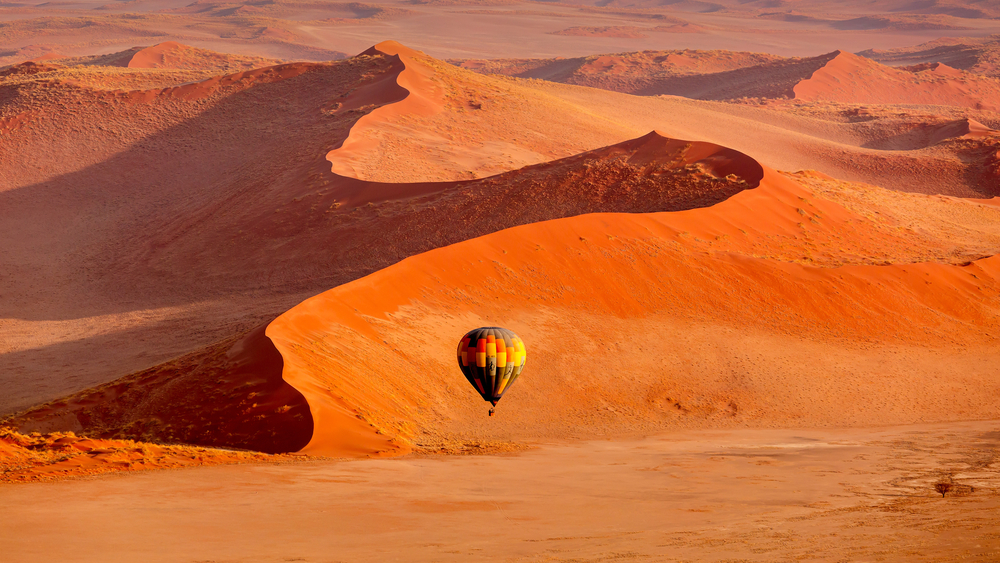Namibia – When the Southern Cross dominates the night sky and a haze covers the barren landscape in the early hours of the day, you can confidently assume that you are in one of the most fascinating regions of Africa.
Namibia is the land of endless expanse and silence. A country whose colors are intense and where the influences of mostly German immigrants mix with the culture of the San, the Herero and the Himba. The Namib Desert, the oldest in the world, gave Namibia its name, and where the wasteland on the other side of the dunes in the Namib-Naukluft National Park is lost, the red of the desert sand blurs in the water bath of the cold Atlantic. Namibia is full of wonders and something like the Eldorado for holidaymakers who leave the beaten tourist path and are enthusiastic about a break that promises the unexpected and adventurous.
The “Singing Dunes” of Sossusvlei
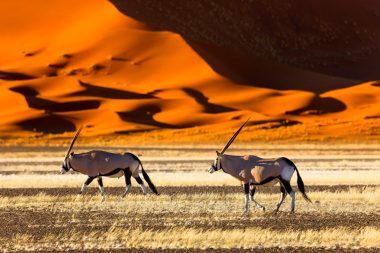
Hardly any other country on our globe enjoys such a large number of dunes as Namibia. For the people of the Namib, they are the real symbols of the country and a playground for the permanent winds that blow over from the Benguela Current. The low water temperatures are the most important factors of the arid climate and the lack of rainfall. The sandy mountains near Sossusvlei are among the outstanding destinations of holidaymakers.
They are a whim of nature – sometimes in constant motion and then again for many years in one spot. The people of the San, who settled this region several centuries ago as gatherers and hunters, speak of the “Singing Dunes”. They fired their imaginations around the campfires and encouraged them to carry on the legends of their ancestors from generation to generation. Over time, the San have shed their shyness of foreign influences and give guests from another world intensive insights into their everyday lives. In the so-called “Living Museums”, the San improve their meagre livelihood and that of their village community.
The largest ship cemetery in the world
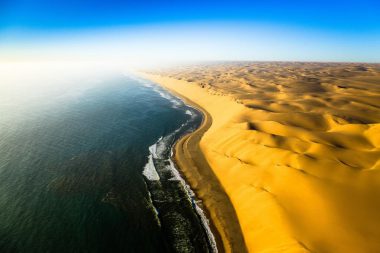
Over a length of more than 1,500 kilometres, the Namibian dune belt stretches along the Atlantic Ocean. From the border with South Africa and the diamond restricted area near Lüderitz to the Skeleton Coast, which sets wildly romantic accents for some visitors and which others describe as rough and inhospitable. This lonely region is one thing in any case: the largest ship cemetery in the world. Where foggy banks spread out over the sea, the captains often lost their bearings. For the shipwrecked, there was then the gruesome alternative between drowning and dying of thirst. If you take your time and have retained a sense of the little things in life, you will meet wondrous creatures on the Skeleton Coast that look as if they came from a distant time under the sun of the south.
The chameleon is a master when it comes to successfully camouflaging itself. Flora and fauna have many surprises in store. For example, the Welwitschia, which owes its unusual name to the Austrian discoverer Friedrich Welwitsch and is something like a living fossil with leaves that can reach a length of up to two meters. It is not particularly photogenic but ancient – some specimens have survived in the Namib desert for up to two thousand years.
Namibia – The abundant wildlife at the “Lake of Tears”
If you have left the monster deserts behind you as a holidaymaker in a rental car or in a coach on the dusty roads of Namibia, the wind turbines on the huge farms alone form the fixed points. Unless a herd of graceful oryx antelopes grazes next to the road or crosses the path. With their long and pointed horns, they sometimes impale a stray lion in dire need. With a little luck, you can also meet them in the wild.
The chances of experiencing the so-called “Big Five” are particularly high in the Etosha National Park. Namibia is proud to present one of the largest game parks in the world. Some call this huge salt pan “Lake of Tears” or “Land of Dry Water”. In the Ovambo language, the word Etosha is rather to be translated as “Great White Square”. On the edge of the salt lake, which dried up millions of years ago, live no less than 110 species of mammals as well as a gigantic bird life.
Untouched nature and drawings in the rock
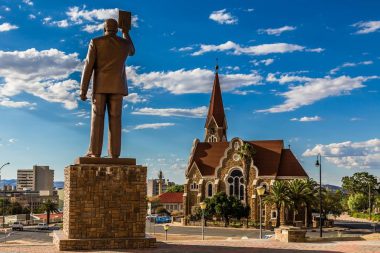
There’s no question about it: Namibia is a paradise for outdoor sympathizers and animal lovers. It is a country where “the desert still lives” and where there are a variety of hiking and trekking trails in a largely unspoiled nature. Not far from the fascinating rock carvings of Twyfelfontein with the famous dancing kudu, the so-called “White Lady” can be visited in the Tsisab Gorge on the Brandberg.
The testimonies of the San carved into the rocks are messages from a time that lies centuries ago. The fact that the pictures were so well preserved is due to the climatic conditions in Namibia with an extremely dry air. But they also encourage people to ask questions about the meaning of life and provide information about the social coexistence of the indigenous peoples in Namibia. Rock art in the northwest is undoubtedly a unique treasure of the country and is now also part of the UNESCO World Heritage Site.
There is always a cool breeze in Swakopmund
The indigenous people of Namibia speak of the “place of emptiness” when they mean the Namib Desert. But in this “emptiness” there are some oases worth seeing. Some of them developed into cities over time. This is also the case with Swakopmund, which becomes a destination for the locals, especially in the months of summer, when the sun burns down from the sky without mercy. In “Swakop” on the Atlantic Ocean, a cool breeze always blows. It is a place where German is the mother tongue of many people who have always lived here. They are the great-grandchildren of those pioneers who came to Namibia during the time of the emperor. There is a lighthouse on the coast, which would also do honor to an island in the North Sea . In Lüderitz, Art Nouveau has never gone out of fashion. From here it is not far to Kolmanskop, the former metropolis of diamond discoveries, swallowed up by the sand. And then there’s Windhoek, the charming Namibian capital, where the “Tafel Lager” beer is brewed according to the German purity laws. There, too, there is a landmark that commemorates the German colonization of the African southwest: the graceful Christ Church. Namibia has many faces. The country is colourful and full of contrasts.
Sights of Namibia at a glance
Etosha National Park

The Etosha National Park is one of the most beautiful and important places in Namibia. As a national park, it is home to 114 species of mammals (including giraffes, lions, cheetahs, rhinos, elephants and many more), over 400 species of birds, 100 different species of reptiles and 16 species of amphibians as well as one species of fish. In this way, the park makes an important contribution to wildlife and nature conservation. An example of this is the success of the Etosha National Park in the protection of black rhinos.
Tourists can drive through the park with their own vehicle or with an expert guide. It should be noted that the vehicle is not allowed to leave, except for fenced-in, specially designated areas. The opening hours of the park are from sunrise to sunset. There is also the possibility to spend the night in the Etosha National Park. With a bit of luck, animals can also be observed from the accommodations. If you stay overnight, you can also enjoy a nightly game drive with an experienced guide.
Bwabwata National Park
The Bwabwata National Park is located at the tip of the Zambezi region and is home to four (lion, leopard, elephant and buffalo) of five species of the so-called “Big Five”. The park is known for its numerous herds of elephants and wild dogs, which are the last of their kind in Namibia. In addition, hippos and crocodiles, other big game and about 400 different bird species can be observed.
Dune 45
Dune 45 got its name from its position (dune number 45 seen from the Atlantic). It is located in the Namib, the oldest desert in the world. The sand of the dune is five million years old. Numerous tourists climb the dune to experience one of the most beautiful views for an evening sundowner.
Another highlight of the Namib is its direct transition to the Atlantic. It is a UNESCO World Heritage Site. The country of Namibia owes its name to the Namib Desert.
Fish River Canyon
550 meters deep, 160 kilometers long, 27 kilometers wide – that’s the Fish River Canyon, the second largest canyon in the world (the largest canyon in the world is the Grand Canyon). An impressive nature experience! Guided hikes through the canyon are offered for tourists. An independent descent without a guide is life-threatening and prohibited. The canyon is located in the ǀAi-ǀAis Richtersveld Transfrontier Park and is estimated to be 500 million years old. It is considered Namibia’s national heritage.
Regions in Namibia
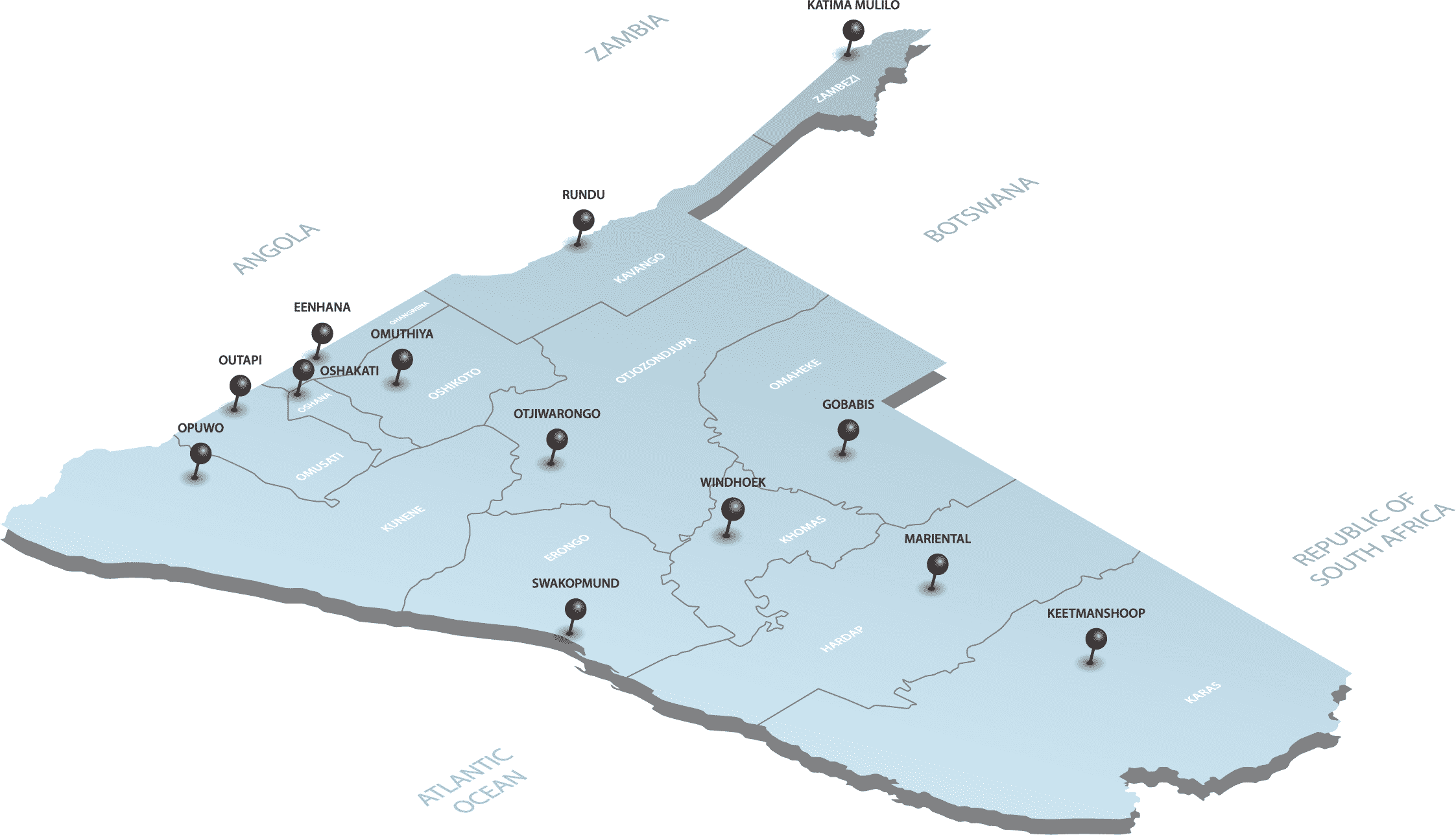
Namibia is divided into thirteen different, separate regions. Each region is worth seeing and has its own highlights and special features. The different regions are:
- Ohangwena
- Omaheke
- Omusati
- Oshikoto
- Otjozondjupa
- Oshana
- Khomas
- Hardap
- Kavango East
- Kunene
- Kavango West
- Erongo
- Zambezi
Most famous cities in Namibia
Windhoek

Windhoek is the capital of Namibia, home to 20 percent of the country’s total population. Windhoek brings together all the important institutions and transport hubs, so the city is well integrated into international air traffic. Since the country is shaped by colonialism, African and European influences can also be found in Windhoek. Examples of European influences are the celebration of carnival and Oktoberfest.
Swakopmund

Swakopmund, affectionately abbreviated to Swakop by many, is located directly on the Atlantic Ocean and in the Namib Desert. The city is the capital of the Erongo region. Swakopmund has a maritime climate due to its location. On a tour, the city is more reminiscent of a city on the German North Sea, so many cafés, restaurants and shops have German names. Highlights of the city are the numerous activities that can be done in Swakopmund: surfing in the dunes or on the water, quad biking in the desert, canoeing with dolphins, trips to the lunar landscape and many more.
Many tourists focus on the “Big Five”, but Swakopmund also offers excursions to discover the “Little Five”. These are small desert dwellers (proboscis, rhinoceros beetles, buffalo weavers, ant lions and panther tortoises).
Otjiwarongo
Otjiwarongo, as the capital of the Otjozondjupa region, is relatively centrally located in the country. On the one hand, it is located on one of the main roads (the B1) in the country, and on the other hand, it is only about 250 kilometers from Windhoek. Behind Otjiwarongo there are many farms, the surrounding area is rather agricultural. Depending on your own interests and wishes, a visit to the various farms in Namibia is also recommended.
Highlights in Otjiwarongo include Waterberg, a crocodile farm that is one of the oldest of its kind, about 50 kilometers away, as well as the AfriCat Foundation and the Cheetah Conservation Fund. These foundations aim to protect African big cats. All of these destinations are definitely worth a visit!
Kolmannskop
Kolmannskuppe is more of a ghost town. In the past, diamonds were mined in this city, which explains the origin of the settlement. This is located in the desert in the Tsau-ǁKhaeb (restricted area) National Park near the port city of Lüderitz. This in turn means that there were no natural, life-affirming resources such as water, soil or electricity available on site. Nevertheless, up to 400 people lived in the city in the past and built up a complete infrastructure, from gymnasiums to schools to ice factories. This infrastructure was completely left behind in its original state and can still be visited in the same way today. A spooky and fascinating sight at the same time!
Due to the relocation of diamond mining, most of the former residents left Kolmannskop in the 1930s, the last person lived in this town until 1960. Today, the desert blows into the buildings.
More information about Namibia
Despite its size of over 800,000 km², Namibia is the country with the second lowest population density in the world. Only Mongolia is more sparsely populated. Namibia has a population of about 2.3 million, which corresponds to 2.83 inhabitants per km². It feels (and probably actually) that there are more giraffes living in Namibia than people.
The weather in Namibia is usually dry and hot with regional differences.


